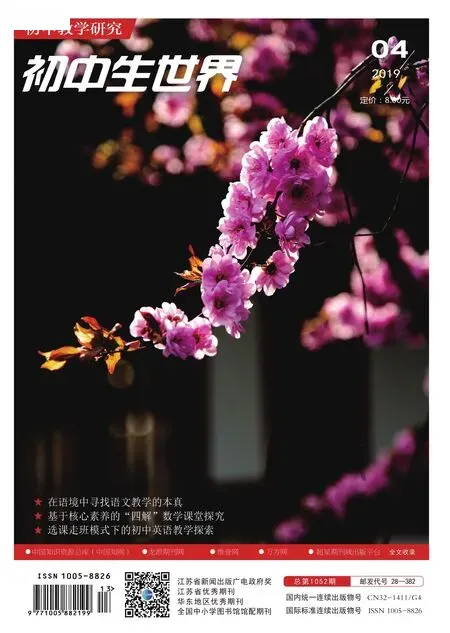8A Unit4 Wild animals Checkout教学设计
■张晓芳
教学案例
一、教材分析
牛津初中英语八(上)第四单元以介绍野生动物及保护野生动物为中心话题。而本课作为本单元的最后一个课时,主要是进一步帮助学生掌握条件状语从句以及because和because of的用法,复习表示野生动物的词汇,并对本单元进行综合复习,进一步激发学生的学习兴趣和保护野生动物的意识。
二、学情分析
经过初一的学习,初二大部分学生能利用已学的英语知识进行简单交流。经过本单元前几课时的学习,学生对野生动物这个话题的相关词汇也有了一定的积累。本课的授课对象为宜兴外国语学校的学生,英语基础好,理解能力和开口能力也强。结合这些实际,笔者以创设情景、合作学习模式展开教学活动。希望完成本课时教材知识学习的同时,学生的团队合作精神、共同探索能力也可以进一步得到提高。
三、设计思想
笔者遵循任务性教学的原则来设计各项语言实践活动,创设真实环境,让学生利用所学知识解决实际问题,采用情景教学法、游戏教学法、竞赛法、合作学习法等多种教学方法。主要流程:导入——拯救熊猫“希望”——讨论保护“野生虎”。
四、教学目标
1.通过复述法、游戏法,学生能复习、巩固与动物有关的词汇和短语。
2.通过练习法、竞赛法,培养学生将名词归类的意识。
3.通过讨论法、归纳法,学生能进一步掌握条件状语从句以及because和because of的用法。
4.通过情景教学法、小组合作法,培养学生团队合作意识,锻炼其与他人协作的能力。
5.通过对野生动物濒临的危险和保护措施的讨论,学生能提升保护动物意识。
五、教学准备
知识层面准备:构思拯救熊猫“希望”的情景,把教材内容、复习回顾、游戏有机地组合在一起;创作阅读材料“野生虎”,并精心设计听、说、读、写各项拓展活动。
课件准备:上网搜索图片、背景音乐,制作多媒体课件。
六、教学过程
Step1 Lead-in.
T:Yixing is famous for its bamboos.There’s a beautiful park with many bamboos in Yixing.Do you know it?(Bamboo Sea.)
PPT投影宜兴竹海图片。
设计意图:通过学校的竹,引出宜兴竹海,把学生带入一个轻松、熟悉的氛围,并完成本课时的导入。
Step2 Saving Xi Wang.
1.Present Xi Wang.
T:In the park,there is a lovely giant panda.She’s Xi Wang.What is she eating?(Bamboos.)Unluckily,some hunters found Xi Wang.They caught her.Xi Wang is in danger now.Do you want to save her?But the forest is so big with four directions.Where is Xi Wang?In the north,south,west or east?Let’s try to find her.
PPT投影熊猫吃竹子的图片和其处于危险之中的图片。
设计意图:根据初中学生正义感强的特点,构设熊猫被猎人捕获的情景,激发学生的兴趣和正义感,号召学生展开拯救“希望”的活动。
2.Ask Ss to introduce the growth of Xi Wang.(North)
T:Is Xi Wang in the north?We should introduce the growth of Xi Wang first.

图1
设计意图:引导学生回顾、复述“希望”的成长史,检测、复习本单元重点的阅读部分。
3.Ask Ss to say the wild animals.(South)
T:Is Xi Wang in the south?We should say these wild animals first.Do you remember them?Boys and girls,let’s have a competition.Who can say the wild animals faster?

图2
设计意图:采用男、女生竞赛的方式,引导学生复习本单元动物名称,并进一步激活课堂。
4.Ask Ss to finish Exercise B(Word groups),check the answers and fill in the blanks.(West)
T:Is Xi Wang in the west?We should finish the exercise first.

图3

图4

图5

图6
设计意图:检测学生对本单元词汇掌握情况的同时,培养学生对名词分类的意识。并在教材练习的基础上,有所拓展,让学生在具体的语境中运用这些词汇,培养学生的句群意识。
5.Ask Ss to finish Exercise A(A short test),check the answers and sum up.(East)
T:Is Xi Wang in the east?We should finish the exercise first.


图8

图9
设计意图:检测学生对本单元语法条件状语从句以及because和because of的掌握情况,鼓励学生讨论、归纳相关用法,促进学生的理解,为后面讨论保护野生老虎做好铺垫,完成语法知识的积累。
6.Conclusion.
T:We saved Xi Wang.She is safe now.Well done!
设计意图:让学生猜测“希望”在森林中可能所在的方位,根据四个方位设计四个环节,有学习,有游戏,让学生在兴趣中学,收获知识的同时,体会救出“希望”的喜悦。
Step3 Wild tigers.
1.Present‘Wild tigers’in danger.
T:Xi Wang is safe now.Unluckily,there’re also many other wild animals in danger.Do you know them?(Wild tigers.)
PPT投影野生老虎被捕杀的照片。
设计意图:通过一系列图片引出“野生老虎”这个话题,直观呈现其恶劣的生存现状,残酷的照片能再次激起学生的正义感和兴趣。设计了一篇主题为“野生老虎”的阅读材料,在此基础上,开展各项拓展延伸活动。
2.Ask Ss to listen to the text twice(T or F questions)and check the answers.
T:Let’s listen to a short passage about Wild tigers.Try to tell me if all the information is right.Before listening,go through these sentences in one minute.
Qs:(1)Wild tigers are large and strong.(T)
(2)Wild tigers have brighter eyes than the other animals.(T)
(3)Wild tigers are not good at swimming.(F)
(4)Wild tigers can run for a long time.(F)
(5)Like giant pandas,baby wild tigers drink their mothers’milk.(T)
(6)There are only about 4200 wild tigers left in the world.(F)
设计意图:让学生通过听的方式,判断信息的正误,进一步了解野生老虎的信息和生存现状,训练听的同时,为下面的读、讨论做好准备。
3.Ask Ss to read the text carefully and silently and try to get the all details.
T:Do you want to know more about wild tigers?Read the passage silently and carefully in five minutes.And try to remember as much information as you can.Time’s up.Try to answer my questions without looking at your paper.
Qs:(1)Do wild tigers have the brightest eyes of all the animals in the world?(Yes,they do.)
(2)Can wild tigers hide themselves in the forests easily?Why?(Yes,they can.Because they have yellow fur and black stripes.)
(3)How much meat does a wild tiger eat every day?(Three kilograms.)
(4)When will wild tigers hurt people?(They are sick and old.)
(5)Why do hunters kill wild tigers?(Because they like their fur and want to make medicine from their bones.)
设计意图:让学生对材料进行精读,要求学生在规定的时间内,记住尽可能多的信息,然后脱离材料,直接回答老师的问题,训练阅读,更培养记信息、听问题的能力,具有一定难度和挑战。设计的问题有易有难,主要围绕野生老虎的外貌、性格、食物、面临的危险来设计。
4.Ask Ss to read through fast and discuss with partners to get the main ideas of each paragraph.
T:Read fast again and discuss in pairs.Try to find main ideas of each paragraph.(Para 1:Appearance and living areas.Para 2:Ability,character and food.Para 3:Danger.)
设计意图:让学生再读文章,理清文章思路,并通过讨论,归纳文章每一段的大意,培养学生的合作、归纳能力以及语篇意识。
Step4 Discussion.
1.Present the‘The Global Tiger Summit’.
T:Wild tiger are in danger now.They only live in 13 countries in the whole world.Do you think we should do something to help them?There’s a summit about wild tigers in Russia.People are talking about how to protect wild tigers.
PPT投影2010俄罗斯“全球老虎峰会”照片。
设计意图:在讨论野生老虎的基础上,结合时政热点——2010俄罗斯“全球老虎峰会”,引导学生关注时事,关心野生老虎生存现状,唤起学生的动物保护意识,鼓励他们加入动物保护的行列。
2.Group Ss into groups of four and have a discussion about‘How to protect wild tigers’.
T:Suppose we’re the students who are attending the meeting.Work in groups of four.Think about‘How to protect wild tiger’.Choose one of you to make a report for the whole group.Try to use‘if’,‘because’,‘because of’in your report.
PPT投影模拟分组讨论情景的图片以及讨论要点提示。
设计意图:结合老虎峰会,把学生假设成参加峰会的不同国家学生代表,鼓励学生在真实的环境下,用新学的词汇、句型、语法进行语言实践活动,分组讨论老虎面临的危险以及保护老虎的措施。
3.Ask some representatives to make a report.
T:Which group can give us a report?
设计意图:预设情景,让学生代表在老虎峰会上做小组发言,用英语进行发言,考验学生的英语运用能力,更考验学生的勇气,将整堂课推向一个高潮,发言学生能体验成功的快乐,所在组的成员也能感受、分享成功的快乐。
Step5 Summary&Homework.
T:I’m happy to see so many good reporters on our class.Many groups did very good jobs.Wild animals are our friends.Remember to love wild animals!That’s love ourselves!Here’s your homework.
以Wild tigers为题,为野生动物俱乐部写一篇报道。要点如下:
1.外貌:体形庞大,眼睛明亮,黄色皮毛,带有黑色条纹。2.习性:擅长游泳,奔跑速度极快,容易捕食其他动物。3.困境:农民不断占用它们的自然保护区;猎人经常为了得到虎皮而猎杀它们;如果我们再不保护它们,世界上将不会再有野生老虎存在。4.行动:我觉得可以采取以下措施帮助它们……
设计意图:课堂结尾升华“爱动物”的主题。课后任务的布置,让学生以‘Wild tigers’为题,为野生动物俱乐部写一篇报道,根据中考写作的要求,采用根据要点进行写作的方式,让学生通过写,将本节课所学的知识进行深化。

